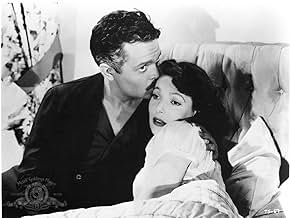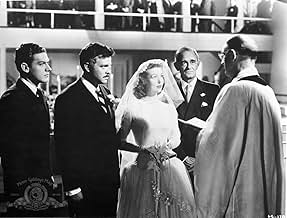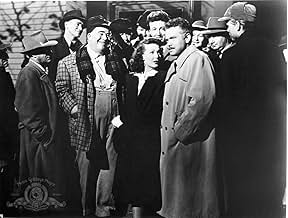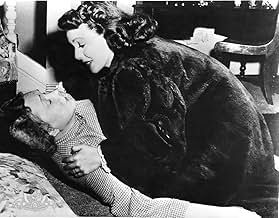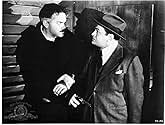VALUTAZIONE IMDb
7,3/10
30.030
LA TUA VALUTAZIONE
Un investigatore della War Crimes Commission si reca nel Connecticut per trovare un famigerato nazista.Un investigatore della War Crimes Commission si reca nel Connecticut per trovare un famigerato nazista.Un investigatore della War Crimes Commission si reca nel Connecticut per trovare un famigerato nazista.
- Regia
- Sceneggiatura
- Star
- Candidato a 1 Oscar
- 2 candidature totali
David Bond
- Student
- (non citato nei titoli originali)
John Brown
- Passport Photographer
- (non citato nei titoli originali)
Nancy Evans
- Undetermined Role
- (non citato nei titoli originali)
Adolph Faylauer
- War Crimes Commision Member
- (non citato nei titoli originali)
Fred Godoy
- Undetermined Role
- (non citato nei titoli originali)
Theodore Gottlieb
- Fairbright
- (non citato nei titoli originali)
Joseph Granby
- Undetermined Role
- (non citato nei titoli originali)
Ethan Laidlaw
- Todd
- (non citato nei titoli originali)
Recensioni in evidenza
This film has been knocked by many people saying that Orson Welles was forced to work within the strict confines of the Hollywood system. I have absolutely no problem with this. Welles is a master craftsman. He made great films, period. In an interview he said that the studio cut out " a couple of reels" that take place in South America at the beginning of the story that he felt was the best part of the movie. As a viewer I feel that the film is compact and taut. Adding more to it would not help(in my opinion). On the contrary, I think adding more might make the film sluggish. As it stands the film remains dark. You feel that evil is present. You are just not sure what is going to happen next.
The performances in this film are for the most part excellent. Edward G. Robinson is amazing. This could have been a cardboard thin good-guy part. Instead he turns the character of Wilson into a smart, cunning hero. He is self-assured not obsessed. He understands what most people in the town don't: Kindler is a monster who is capable of anything. To catch such a man you have to be several steps ahead of him. Also excellent is Konstantin Shayne as Meinike. You can see the fear and madness in his eyes as he repeats "I am travelling for my health, I am travelling for my health..." before going through customs. Make no mistake, this man is "an obscenity that must be destroyed" to quote Wilson. Just look at his scene with the photographer in South America. He is used to people following his orders. Welles is also very good as Kindler/Rankin. There are moments that you actually feel sympathy for him. His obsession with fixing the town clock is very significant. Here is a man who needs things to be precise and structured. He wants total control of his environment(a good example is how he treats his wife). Welles hints at this man's mania but keeps him human. Even though you want him to be caught, you can't help wondering if he'll get away. Loretta Young is unfortunately just average in this film. She has some good moments (especially in the final scene when she confronts Rankin/Kindler)but her hysterics are just too much. The scene where Wilson is showing her the Nazi atrocities is well played. She keeps a certain composure that works well.
Overall, a very well made thriller with top notch performances and solid direction by one of cinema's masters. I give it 8 clock towers out of 10.
The performances in this film are for the most part excellent. Edward G. Robinson is amazing. This could have been a cardboard thin good-guy part. Instead he turns the character of Wilson into a smart, cunning hero. He is self-assured not obsessed. He understands what most people in the town don't: Kindler is a monster who is capable of anything. To catch such a man you have to be several steps ahead of him. Also excellent is Konstantin Shayne as Meinike. You can see the fear and madness in his eyes as he repeats "I am travelling for my health, I am travelling for my health..." before going through customs. Make no mistake, this man is "an obscenity that must be destroyed" to quote Wilson. Just look at his scene with the photographer in South America. He is used to people following his orders. Welles is also very good as Kindler/Rankin. There are moments that you actually feel sympathy for him. His obsession with fixing the town clock is very significant. Here is a man who needs things to be precise and structured. He wants total control of his environment(a good example is how he treats his wife). Welles hints at this man's mania but keeps him human. Even though you want him to be caught, you can't help wondering if he'll get away. Loretta Young is unfortunately just average in this film. She has some good moments (especially in the final scene when she confronts Rankin/Kindler)but her hysterics are just too much. The scene where Wilson is showing her the Nazi atrocities is well played. She keeps a certain composure that works well.
Overall, a very well made thriller with top notch performances and solid direction by one of cinema's masters. I give it 8 clock towers out of 10.
It's quite interesting to see two acting legends like Orson Welles and Edward G. Robinson working together, and with a cast that includes those two plus Loretta Young, along with an interesting story, "The Stranger" is a pretty good thriller.
Welles and Robinson play an interesting cat-and-mouse game in the search for a former Nazi who is hiding out in a peaceful Connecticut town. It's fair to point out, as others have done, that the dialogue at times leaves a little to be desired, but Welles and Robinson have more than enough ability to carry it off anyway.
Loretta Young has a difficult role as the wife of Welles's character. The script does her no favors, either, but she gives a creditable performance as a character who is important to the story. Among the supporting cast, Billy House particularly stands out, getting surprisingly good mileage out of his role as the store-keeper.
Perhaps the most creative aspect of the movie is the effective use of the clock tower, both as a plot device and as an idea, along with the related themes of clocks and time. The tense climax makes good use of all of these elements.
Welles and Robinson were both parts of so many outstanding movies that sometimes their merely good movies can seem to suffer by comparison. As long as you don't try to compare "The Stranger" with some other film, but just watch it for itself, it's a good thriller and an entertaining movie.
Welles and Robinson play an interesting cat-and-mouse game in the search for a former Nazi who is hiding out in a peaceful Connecticut town. It's fair to point out, as others have done, that the dialogue at times leaves a little to be desired, but Welles and Robinson have more than enough ability to carry it off anyway.
Loretta Young has a difficult role as the wife of Welles's character. The script does her no favors, either, but she gives a creditable performance as a character who is important to the story. Among the supporting cast, Billy House particularly stands out, getting surprisingly good mileage out of his role as the store-keeper.
Perhaps the most creative aspect of the movie is the effective use of the clock tower, both as a plot device and as an idea, along with the related themes of clocks and time. The tense climax makes good use of all of these elements.
Welles and Robinson were both parts of so many outstanding movies that sometimes their merely good movies can seem to suffer by comparison. As long as you don't try to compare "The Stranger" with some other film, but just watch it for itself, it's a good thriller and an entertaining movie.
The IMDb trivia page says this is Orson Welles's least favorite and least personal film. Aside from "Citizen Kane" and "The Magnificent Ambersons," I think this potent film noir is his most enjoyable—certainly more so than the ugly "Lady from Shanghai" or the overbaked and convoluted "Touch of Evil."
Charles Rankin (Orson Welles) is a professor in a respectable Connecticut town about to marry the daughter of a U.S. Supreme Court justice. But his name is fake and his past is filthy. An earnest convert to Christianity (Konstantin Shayne), who once ran a Nazi concentration camp, is capable of exposing him. "Rankin" kills this little old man and buries his body in the forest. But he isn't safe because an investigator (Edward G. Robinson) from the War Crimes Commission is on his tail. Rankin needs his own wife (Loretta Young) to help him elude capture. But his fascination with the local clock tower may prove his undoing.
As a director, Welles strains a bit too hard for effect in this film—and much too hard in everything but "Kane" and "Ambersons." In those two films all of his technical effects, striking as they are, seem effortless and exactly the right choices. Here, he has imperfect moments—such as the scene where his character is frantically, and inexplicably, trying to pick up pieces of paper—but everything else is splendid, especially the climax.
As an actor he's always compelling, but I think he makes one bad choice here. He's too guilty-looking in the early scenes. It makes us wonder why no one suspects him; and it robs us of a dramatic contrast when he begins to realize he's in imminent danger.
Loretta Young is generally a dull actress. She doesn't have enough skill to make an impression in the early scenes; but once the part requires histrionics she performs her duties well enough. Certainly her character is morally dubious and therefore fascinating in itself.
The best performance by far is Edward G. Robinson's. One of the great actors of his time, this ugly man has enough talent and star quality to underplay his role to great effect.
Orson Welles fans might find this exciting, well-plotted thriller too un-Wellesian to suit them. Otherwise, this is highly recommended.
Charles Rankin (Orson Welles) is a professor in a respectable Connecticut town about to marry the daughter of a U.S. Supreme Court justice. But his name is fake and his past is filthy. An earnest convert to Christianity (Konstantin Shayne), who once ran a Nazi concentration camp, is capable of exposing him. "Rankin" kills this little old man and buries his body in the forest. But he isn't safe because an investigator (Edward G. Robinson) from the War Crimes Commission is on his tail. Rankin needs his own wife (Loretta Young) to help him elude capture. But his fascination with the local clock tower may prove his undoing.
As a director, Welles strains a bit too hard for effect in this film—and much too hard in everything but "Kane" and "Ambersons." In those two films all of his technical effects, striking as they are, seem effortless and exactly the right choices. Here, he has imperfect moments—such as the scene where his character is frantically, and inexplicably, trying to pick up pieces of paper—but everything else is splendid, especially the climax.
As an actor he's always compelling, but I think he makes one bad choice here. He's too guilty-looking in the early scenes. It makes us wonder why no one suspects him; and it robs us of a dramatic contrast when he begins to realize he's in imminent danger.
Loretta Young is generally a dull actress. She doesn't have enough skill to make an impression in the early scenes; but once the part requires histrionics she performs her duties well enough. Certainly her character is morally dubious and therefore fascinating in itself.
The best performance by far is Edward G. Robinson's. One of the great actors of his time, this ugly man has enough talent and star quality to underplay his role to great effect.
Orson Welles fans might find this exciting, well-plotted thriller too un-Wellesian to suit them. Otherwise, this is highly recommended.
Stylish noir trading on public's concern with escaped Nazis following WWII. First part is especially intriguing since we can't be sure what's happening or who Franz Kindler is. The atmosphere is typically Wellesian— shadows galore, imaginative camera set-ups, along with dramatic use of sound. Two features, however, standout for me.
Once the plot comes into focus, we know Kindler (Welles) must do away with Meinicke (Shayne), but how. The forest scene is inspired, more menacing I think than the finale. The two men are on bended knee, in apparent communion with the forces of good, except one of them is not.
Second is Welles' depiction of small town America through druggist Potter (House, in a splendid performance). Grossly over-weight, he sits all day in front of his checkerboard, hoping to entice some sucker into a game, so he can cheat them out of a quarter. Worse, he makes customers serve themselves, apparently so he won't have to move his bulk. Not exactly the neighborly small town of Shadow of a Doubt (1943), for example.
Given the movie's many arresting features, I'm not sure why its profile isn't higher among both noirs and the Welles canon. My best guess concerns a general absence of ambiguity among both characters and situations. Instead, the screenplay is a straight pursuit film of good vs. evil that makes good use of cat and mouse, and of atmosphere, but is unexceptional in storyline. So if you're looking for stylish suspense without tricky moral complications, this is a movie to catch.
Once the plot comes into focus, we know Kindler (Welles) must do away with Meinicke (Shayne), but how. The forest scene is inspired, more menacing I think than the finale. The two men are on bended knee, in apparent communion with the forces of good, except one of them is not.
Second is Welles' depiction of small town America through druggist Potter (House, in a splendid performance). Grossly over-weight, he sits all day in front of his checkerboard, hoping to entice some sucker into a game, so he can cheat them out of a quarter. Worse, he makes customers serve themselves, apparently so he won't have to move his bulk. Not exactly the neighborly small town of Shadow of a Doubt (1943), for example.
Given the movie's many arresting features, I'm not sure why its profile isn't higher among both noirs and the Welles canon. My best guess concerns a general absence of ambiguity among both characters and situations. Instead, the screenplay is a straight pursuit film of good vs. evil that makes good use of cat and mouse, and of atmosphere, but is unexceptional in storyline. So if you're looking for stylish suspense without tricky moral complications, this is a movie to catch.
Infamous Nazi war criminal called Franz Kindler (Orson Welles) assumes a new respectable identity in a Midwestern little town following WWII , unaware that a government agent (Edward G. Robinson) from the Allied War Crimes commission patiently stalks him . But his name is fake and his past is tenebrous . The escaped Nazi sedately living and is about to marry a beautiful as well as unsuspecting young woman (Loretta Young) , daughter of a prestigious judge (Philip Merivale) . But later on , Kindler feels his past closing in and he will need his own spouse to help him elude capture .
Interesting Welles movie with plenty of thrills , fine character studio , terrific interpretations and suspense from start to finish . It holds the viewer's interest but admittedly has some flaws , naive moments and wobbles . But it is studded with splendid scenes like the furtive flight across the dockyards at the beginning , the killing in the forests and the final confrontation on the clock tower including the sword wielded mechanical figures that move when the hour begins to strike . The vast New England town exterior sets, including the church with its 124-foot clock tower, were constructed in Hollywood on the back lot of the United Artists studio located on Santa Monica Blvd . Shocking scenes when are shown images about Nazi crimes , in fact it was the first mainstream American movie to feature footage of Nazi concentration camps following World War II . Nice acting by Orson Welles as a Nazi criminal who feels fascination with antique clocks and sedately esconsced in a small Connecticut town when an investigator is tailing him . Edward G. Robinson is perfect as a Federal agent out to get him . However , Orson Welles originally wanted Agnes Moorehead to play the FBI part , then the studio said no and instead gave him Edward G. Robinson . Furthermore , Loretta Young as attractive wife and Richard Long as brother give nicely understated interpretations . Suspenseful and thrilling musical score by Bronislau Kaper . Extremely well made camera-work throughout ; being shot in black and white filled with lights and darks by excellent cameraman Russell Metty . It is also available in horrible computer-colored version .
¨The stranger¨ was efficiently produced by Sam Spiegel and well directed by Orson Welles in 95 minutes runtime , being the only film directed by him to show a profit in its original release . However , Orson has stated that this is his least favorite of his films . Welles was a genius who had a large as well as problematic career . In 1938 he produced "The Mercury Theatre on the Air", famous for its broadcast version of "The War of the Worlds" . His first film to be seen by the public was ¨Ciudadano Kane¨ (1941), a commercial failure , but regarded by many as the best film ever made , along with his following movie , ¨The magnificent Ambersons¨ . After that , he directed this ¨The stranger¨ with an over-pitched acting by the same Welles and often described as his worst . He subsequently directed Shakespeare adaptation such as ¨Macbeth¨ , ¨Othelo¨ and his highly enjoyable ¨Chimes at Midnight¨ or ¨Falstaff¨ . He also performed a lot of films , Orson Welles interpreted for getting financing to shoot his pictures , as he played several exotic characters such as ¨The Tartari¨ , ¨Saul¨ , ¨Cagliostro¨ , ¨Cesare Borgia¨ and ¨Black rose¨ . Many of his next films were commercial flops and he exiled himself to Europe in 1948 . In 1956 he directed ¨Touch of evil¨ (1958) ; it failed in the U.S. but won a prize at the 1958 Brussels World's Fair . In 1975, in spite of all his box-office failures , he received the American Film Institute's Lifetime Achievement Award , and in 1984 the Directors Guild of America awarded him its highest honor, the D.W. Griffith Award . His reputation as a film maker has climbed steadily ever since .
Interesting Welles movie with plenty of thrills , fine character studio , terrific interpretations and suspense from start to finish . It holds the viewer's interest but admittedly has some flaws , naive moments and wobbles . But it is studded with splendid scenes like the furtive flight across the dockyards at the beginning , the killing in the forests and the final confrontation on the clock tower including the sword wielded mechanical figures that move when the hour begins to strike . The vast New England town exterior sets, including the church with its 124-foot clock tower, were constructed in Hollywood on the back lot of the United Artists studio located on Santa Monica Blvd . Shocking scenes when are shown images about Nazi crimes , in fact it was the first mainstream American movie to feature footage of Nazi concentration camps following World War II . Nice acting by Orson Welles as a Nazi criminal who feels fascination with antique clocks and sedately esconsced in a small Connecticut town when an investigator is tailing him . Edward G. Robinson is perfect as a Federal agent out to get him . However , Orson Welles originally wanted Agnes Moorehead to play the FBI part , then the studio said no and instead gave him Edward G. Robinson . Furthermore , Loretta Young as attractive wife and Richard Long as brother give nicely understated interpretations . Suspenseful and thrilling musical score by Bronislau Kaper . Extremely well made camera-work throughout ; being shot in black and white filled with lights and darks by excellent cameraman Russell Metty . It is also available in horrible computer-colored version .
¨The stranger¨ was efficiently produced by Sam Spiegel and well directed by Orson Welles in 95 minutes runtime , being the only film directed by him to show a profit in its original release . However , Orson has stated that this is his least favorite of his films . Welles was a genius who had a large as well as problematic career . In 1938 he produced "The Mercury Theatre on the Air", famous for its broadcast version of "The War of the Worlds" . His first film to be seen by the public was ¨Ciudadano Kane¨ (1941), a commercial failure , but regarded by many as the best film ever made , along with his following movie , ¨The magnificent Ambersons¨ . After that , he directed this ¨The stranger¨ with an over-pitched acting by the same Welles and often described as his worst . He subsequently directed Shakespeare adaptation such as ¨Macbeth¨ , ¨Othelo¨ and his highly enjoyable ¨Chimes at Midnight¨ or ¨Falstaff¨ . He also performed a lot of films , Orson Welles interpreted for getting financing to shoot his pictures , as he played several exotic characters such as ¨The Tartari¨ , ¨Saul¨ , ¨Cagliostro¨ , ¨Cesare Borgia¨ and ¨Black rose¨ . Many of his next films were commercial flops and he exiled himself to Europe in 1948 . In 1956 he directed ¨Touch of evil¨ (1958) ; it failed in the U.S. but won a prize at the 1958 Brussels World's Fair . In 1975, in spite of all his box-office failures , he received the American Film Institute's Lifetime Achievement Award , and in 1984 the Directors Guild of America awarded him its highest honor, the D.W. Griffith Award . His reputation as a film maker has climbed steadily ever since .
Lo sapevi?
- QuizThis was the first mainstream American movie to feature footage of Nazi concentration camps following World War II.
- BlooperTwo palm trees are visible in the first scene depicting the fictional Connecticut town.
- Citazioni
Mr. Wilson: Well, who but a Nazi would deny that Karl Marx was a German because he was a Jew?
- Versioni alternativeAlso available in a computer-colorized version.
- ConnessioniEdited into Ninja the Mission Force: Citizen Ninja (2012)
I più visti
Accedi per valutare e creare un elenco di titoli salvati per ottenere consigli personalizzati
Dettagli
Botteghino
- Budget
- 1.034.000 USD (previsto)
- Tempo di esecuzione1 ora 35 minuti
- Colore
- Proporzioni
- 1.37 : 1
Contribuisci a questa pagina
Suggerisci una modifica o aggiungi i contenuti mancanti

Divario superiore
By what name was Lo straniero (1946) officially released in India in Hindi?
Rispondi


